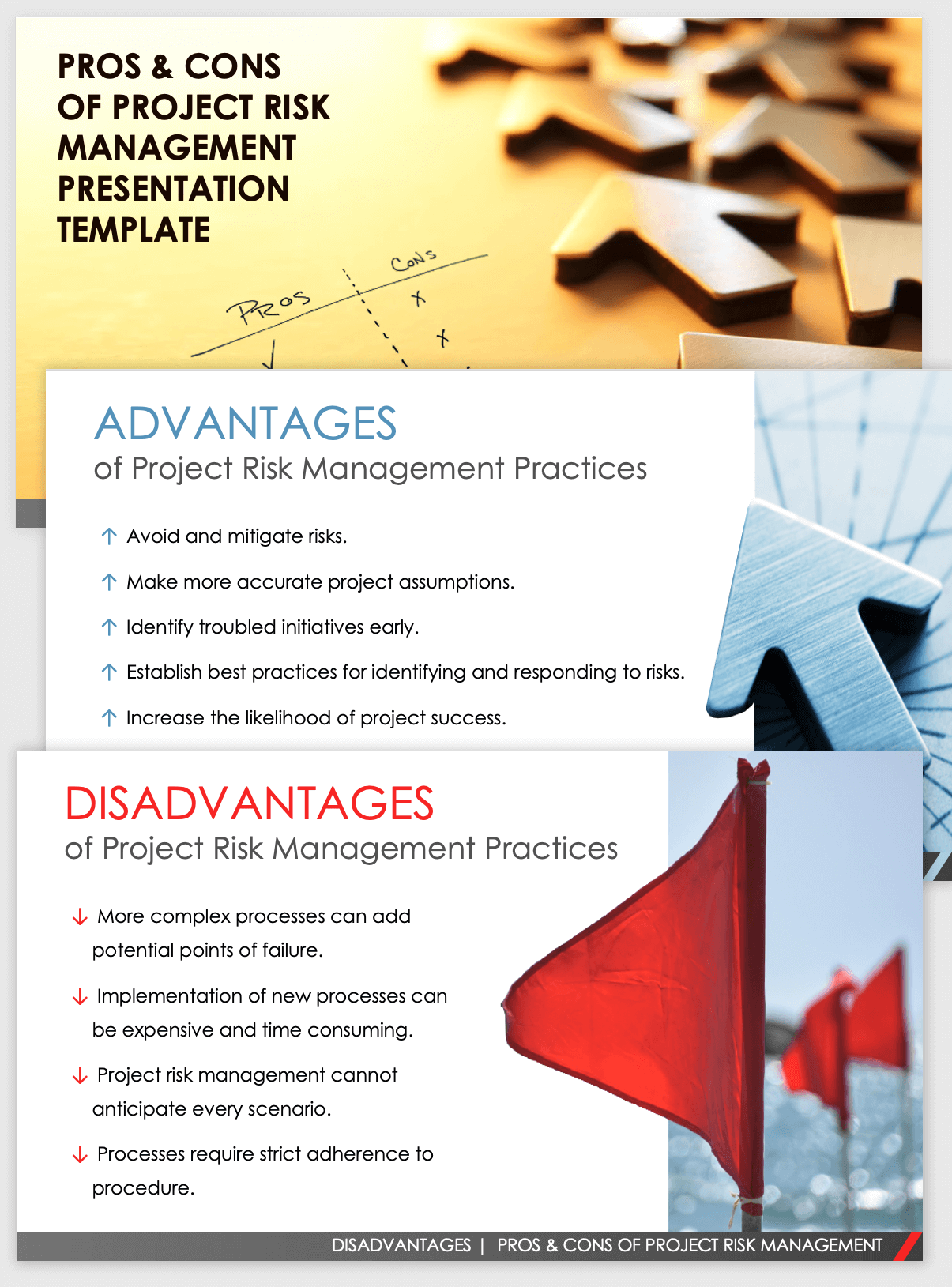Advantages of Project Risk Management
Project risk management offers many distinct advantages to an organization, including more accurate project projections, increased return on investments (ROI), and greater executive support and trust.
We’ve outlined the major advantages of adopting risk management processes below:
- Increased Opportunity for Identifying and Avoiding Risks: The first and most important advantage is that clear risk management processes make it easier to mitigate and avoid risk. By establishing processes to identify risks early, companies are better able to react successfully, before those risks become larger problems.
- More Accurate Project Projections:
- Jeff Mains, the CEO of Champions Leadership Group, LLC, explains how project risk management processes help increase accuracy in budget projections. “Improved data quality is, without a doubt, a critical component of various risk management advantages,” he says. “When risk potential is identified early, it has a favorable influence on the budgeting process. It can help you more accurately calculate a budget.”
- Earlier Identification of At-Risk Projects:
- It is easier to notice when a project is in trouble if risk management practices are in place as a standard process. “Risk management helps you spot the red flags that are raised from the start from high-probability risk events,” says David Reid, the Sales Director at VEM Tooling. “Risk management forces the project team to be aware of potential risks and quickly adapt to risk events as they emerge.”
- Ability to Grow and Evolve: Risk management processes improve as you gather and react to risks over time. The more experience your teams have with assessing and controlling risks, the more effective they will be.
- Increased Return on Investment (ROI): It goes without saying that projects produce better returns when they are completed on time and on budget. Projects that encounter fewer risks are more likely to stick closely to their original project plans.
- Increased Executive Support for Initiatives: Project managers with proven track records for avoiding and managing risks are more likely to gain the trust and approval of their sponsors.
Benefits of Project Risk Management
In addition to concrete business advantages, adopting project risk management processes can bring numerous, less tangible benefits to your organization, such as better communication, improved team engagement, and increased project visibility.
We’ve detailed these and other benefits in the list below:
- Increased Individual Focus: Your team will be better able to focus on the tasks at hand when they know that they are less likely to encounter roadblocks. “[Having] efficient risk management strategies integrated into your project management processes improves the mentality of your whole team,” says Mains. “Team members will understand that risks are being actively handled, and as a result, there is a much lower likelihood of failure.”
- Better Communication Between Teams and Sponsors: Establishing a practice of proactive communication about risks can make communicating with sponsors more productive across the board. “A well-implemented risk strategy specifies the standards for disseminating risk information up and across the company. This means that project sponsors and key stakeholders are aware of new information as it becomes available, whether it is good or bad,” says Reid.
- More Engaged Team Members:
- Involving your team in the planning and risk management process helps to increase their engagement in the project as a whole. “Sometimes, just having your whole team be aware of the risks can lead to them being more conscious of how they’re working,” explains Jonathan R. Brockman, Founder of Jonathan R. Brockman, P.C., a private personal injury practice. “Going through the risks as a team has been incredibly beneficial for us long-term.”
- Fewer Surprises: Catching potential risks early leads to fewer surprises and a more stable and predictable workflow.
- Sets Expectations for Success: Establishing a risk management plan telegraphs to everyone that you care about the project’s success. Your teams and sponsors are more likely to buy in when it’s clear that you are committed to smooth project completion.
- Establishes Project Visibility Practices: Project visibility leads to more cohesive teams and increased executive buy-in, and also establishes an environment of openness of communication. Project risk management practices help to foster an atmosphere of visibility, as everyone is focused on avoiding risk.
Disadvantages of Project Risk Management
As with any major initiative, implementing project risk management practices comes with its share of disadvantages. You might find that more complex processes lead to more opportunities for failure or that the cost of implementation is greater than expected.
We’ve compiled the major potential disadvantages of project risk management in the list below, as well as tips for managing them.
- More Complexity Can Add More Opportunities for Failure: In any situation, more complex processes can increase the possibility for points of failure. When you implement risk management practices, there is the chance that those practices themselves can introduce additional risks that must be managed as well.
“While the potential benefits of risk management can result in flourishing situations, the downsides can impact revenue,” says Reid. “We have encountered a plethora of laws and regulations that must be followed; otherwise, substantial fines and penalties will be imposed. As we use more software, there are increased possibilities for hacking as we use the internet and mobile channels to share personal data. These risks can compromise your customers' trust in your company and tarnish your brand, and you may be held financially accountable for any data breaches or fraud.”
The best way to combat these additional risks is to apply your risk management practices to them. No initiatives are entirely without risk, and in this situation, the benefits of implementing risk management strategies greatly outweigh the potential effects those risks might have without those strategies in place. - Requires Strict Adherence to Procedures: Risk management requires all employees to adhere to the policies you put in place to function properly. “We once had an employee who insisted on taking on their clients and projects completely individually,” Brockman relates. “They rarely asked for input or help when needed, even when the project in question wasn’t completely within their areas of expertise. Ultimately, this led to the employee being completely burnt out and exhausted to the point that they lost a very big client over easily avoidable mistakes.”
As with any other important procedures, project managers must make it clear to their teams that these practices must be followed perfectly every time, or disciplinary consequences will follow. A chain is only as strong as its weakest link, and a company is only as risk avoidant as its riskiest employee. - Impossible to Predict Everything: You can’t predict every risk event. You will spend time and money anticipating risks that do not happen; conversely, you will probably be faced with risks you didn’t see coming.
But as you continue to enforce risk management policies in the workplace, your experience will lead to improved risk identification in the future. Every risk that doesn’t happen is only that which can occur later, and every new risk is a learning experience. Encourage an environment of growth, and build your risk management strategies over time. - Cost: Implementing risk management practices requires time and money, which often must be routed away from other business tasks. Also consider the cost of any needed software or professional consultants, as well as the residual cost of ongoing practices.
Ultimately, however, risk management is insurance for your business. Think of the costs involved as the premium to ensure that you do not lose more money later. Most project risks involve substantially more to lose than the cost of implementing risk management strategies in the first place.
Pros and Cons of Project Risk Management
Risk management practices come with pros and cons. One the one hand, they can improve your ability to identify and avoid risks early; on the other, they require everyone to adhere to strict procedures and might cost money to implement.
In the chart below, we quickly summarize the pros and cons of adopting risk management practices for your teams:
| Pros | Cons |
|---|---|
| Improved avoidance and mitigation of risks | Requires strict adherence to procedure |
| Better identification of troubled initiatives | Impossible to anticipate everything |
| Helps to establish best practices for identifying and responding to risks | Increased costs related to implementation and ongoing processes |
| Allows for you to make more accurate project projections | Adding complexity to processes leads to more possible points of failure |
| Increased likelihood of project success | |
| Creates processes that can be built upon and shared | |
| Increased executive support for initiatives |
Pros and Cons of Project Risk Management Presentation Template
Download Pros and Cons of Project Management Slide Presentation
Microsoft PowerPoint
| Google Slides
Use this presentation template to help build the case for project risk management in your own organization. This fully customizable template comes prefilled with the pros and cons of implementing project risk management covered in this article, and also includes space to add your personal examples. We’ve also included a side-by-side comparison slide to summarize the advantages and disadvantages that risk management can bring to your business.
Streamline Your Risk Management Efforts in Real Time with Smartsheet
Empower your people to go above and beyond with a flexible platform designed to match the needs of your team — and adapt as those needs change.
The Smartsheet platform makes it easy to plan, capture, manage, and report on work from anywhere, helping your team be more effective and get more done. Report on key metrics and get real-time visibility into work as it happens with roll-up reports, dashboards, and automated workflows built to keep your team connected and informed.
When teams have clarity into the work getting done, there’s no telling how much more they can accomplish in the same amount of time. Try Smartsheet for free, today.



